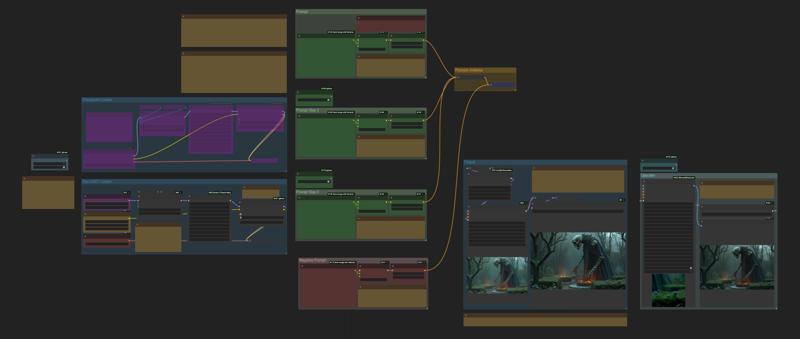Verified: a year ago
Other
The FLUX.1 [dev] Model is licensed by Black Forest Labs. Inc. under the FLUX.1 [dev] Non-Commercial License. Copyright Black Forest Labs. Inc.
IN NO EVENT SHALL BLACK FOREST LABS, INC. BE LIABLE FOR ANY CLAIM, DAMAGES OR OTHER LIABILITY, WHETHER IN AN ACTION OF CONTRACT, TORT OR OTHERWISE, ARISING FROM, OUT OF OR IN CONNECTION WITH USE OF THIS MODEL.
Where do I begin...
I was just messing around with nodes and found out I could set a start and stop step for a prompt, at first it didn't make sense to me until I realized I could combine different prompts with a different guidance scale value... And even the exact same prompt with different guidance values (For prompt adherence + realism in the second and third step.)
This would allow to split the composition/scene into different sections with different details and respective guidance scale values.
I also found out that negative prompts do work with Flux, but not like they're supposed to. After some testing, it turns out the lower the CFG, the more prominent the negative prompt will be, and it will act as a positive prompt.
For example, with a CFG=0 or 0.5, it will BE the positive prompt! And with a CFG=0.8, both the positive and negative prompts will combine together, this could be really useful if you want to combine/overlay different styles together (Further testing is needed though.)
Also, an empty negative prompt with a high guidance scale value affects the output for some reason!
*** And yeah, I also found out that I can use a CFG value other than "1" with the help of the node "DynamicThresholdingFull" which allows for a high CFG values like 6 with the Flux model, which is kind of insane!
Shout out to /u/Total-Resort-3120 who accidentally found a solution to an issue I wasn't looking for at the moment, which made me do this workflow!
And also thanks to him for the correct settings in the "DynamicThresholdingFull" node!
I added on/off switches above groups that can be disabled/enabled so it's very practical!
TL;DR
I made it possible to separate the prompt into several parts to allow for more fine tuning
I made it possible to use a value other than 1 for the CFG in the Sampler


